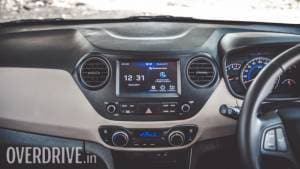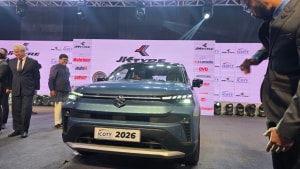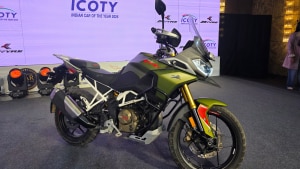All-new Hyundai Santro first impressions
We were invited to Hyundai's R&D team in Chennai to get a sneak peek of the 2019 Hyundai Santro - the successor to Hyundai's entry-level that kickstarted operations for the brand in India back in 1998. Back then, the Santro was an entry-level compact offering and that place has now been taken up by the Eon. The new Santro fits between that at the Grand i10, filling the void created by the erstwhile i10.
Design
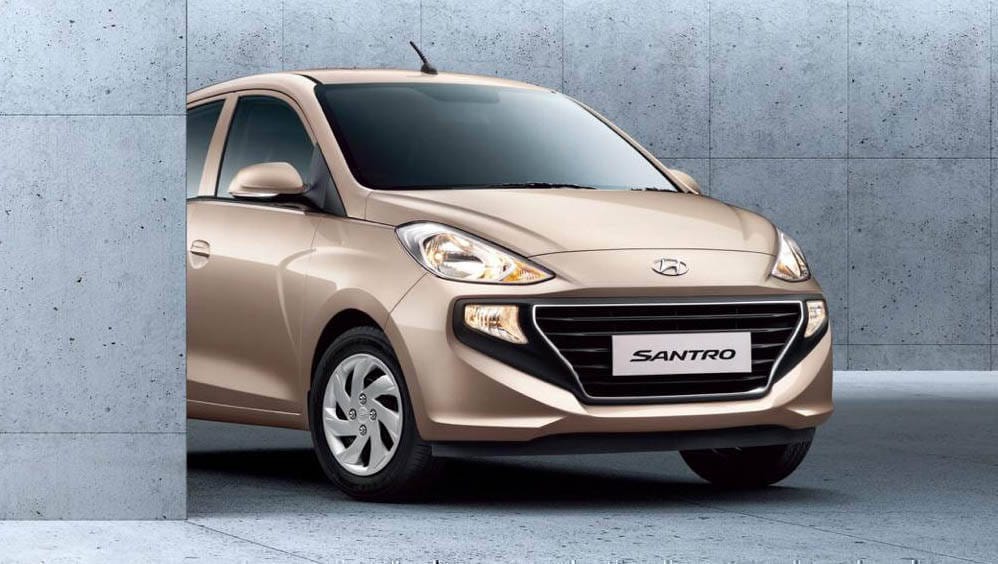
Look at the new Santro and you will instantly realise that it fills into the i10 shoes. The facia is reminiscent of the i10 with its rather cute headlights. Hyundai's designers have nicely managed to give it hints of the design theme that's being followed by their new generation of crossovers/SUVs like the Kona or the Santa Fe. The new cascading grille sits significantly lower than the bonnet, and there is no grille element between the Santro's single-pot headlights, making the bonnet and the nose longer than it is.
The grille integrates two large fog-lamps to mimic the face of the aforementioned Hyundai SUVs. But that positioning is rather high in my opinion as fog lamps usually function best when they are closer to the ground. Their inclusion in the grille also leaves two empty spots on the other ends of the front bumper, which I believe will become a popular spot for aftermarket daytime running lights. The top trims feature wing mirror mounted blinkers.
The tailgate has a very sober design to it. The squarish taillights are functional and their small proportions allow for a large tailgate and rear windshield. There is no rear fog lamp, but two reflective strips and a dual-tone theme make sure that the rear bumper doesn't look drab. The Santro sits on 14-inch wheels that look surprisingly proportionate despite their small diameter and that is thanks to the well-proportioned wheel arches and a large glasshouse.
We also particularly like the boomerang-shaped crease over the front wheel arch. Oh extends into the doors and adds some complexity to the side profile. It is complemented by another prominent crease over the rear wheel arch and a kink in the rear window line. Another subtle crease connects the window line to the taillight, giving the side profile a layered design.
Cabin
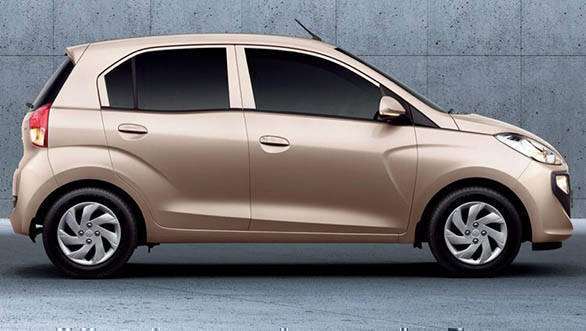
The rear doors have an angular design, allowing a wider design and in turn, easier ingress and egress. They also feature a quarter glass, allowing great visibility even for rear seat occupants. Visibility overall is excellent - not only for all passengers and the driver, but also through the rear windshield, translating into easy judgement for first time buyers. I fact, first time buyers are the target audience for the new Santro and there is plenty in the cabin to pamper them.
There is an exclusive Dyna Green shade (similar to the Kona's signature colour), which features matching green accents in the cabin by way of the seatbelts, upholstery stitching, A/C bezels and infotainment switches - all in the same neon green finish! It looks quite refreshing and youthful and I had a childish excitement when I first saw it. Carmakers like Lamborghini will charge you lakhs for matching the stitching and the seatbelts to the exterior colour and here it is, available in an entry-spec car! This treatment is only available on the green colour though.
What's also astonishing for this segment is the inclusion a 7-inch touchscreen infotainment with sat-nav and new-age connectivity options like Apple CarPlay, Android Auto and Mirrorlink. It's the same infotainment system as the Grand i10 and sounds equally great. What I also like is that the individual switches for the infotainment system are nicely tucked behind a seamless rubber strip (something like a waterproof silicone case for your gadget). Theoretically, that's a nice touch for ensuring longevity of the switches in our dusty conditions.
Speaking of which, Hyundai continues to use its favourite black and beige combination in the Santro as well and the carmaker says that the design of the centre console is inspired from the face of an elephant. There is no chrome garnish anywhere in the car, and I'm not complaining. The Santro doesn't get keyless go or climate control. The air conditioner features a 135cc compressor and there is a set of rear A/C vents too and even in the humid weather at Chennai, it cooled the cabin in no time. As our AC test suggests, Hyundai cars often have excellent cooling efficiency and their new baby falls in line with that tradition.
The rage topper also gets powered mirrors and power windows. The switches to the latter are placed on the tunnel console aft of the gear shifter and yet there is plenty of storage space for knickknacks. That placement has also allowed the designers to further scoop into the door pads to improve foot and knee space at the front. All four door pockets can easily hold 1l bottles too.
Space intimidation, in fact, is the strong point of the Santro's cabin. The room at the rear is impressive with excellent headroom and knee room. The rear seat has a near flat contouring to maximise shoulder room for three. The rear seat back doesn't have a 60:40 split but is collapsible. There are four integrated headrests, though I would have liked to see adjustable restraints from a safety stand point.
Safety
Speaking of safety, the Santro gets ABS and driver side airbag as a standard fit. Higher trims will offer a front passenger airbag too. The driver's seat isn't adjustable for height and the steering can't be adjusted for reach. Hyundai claims to have tested the Santro extensively for frontal and side impact collisions and assure that it has the best in class cabin safety. To that effect, up to 63% of the chassis is made from high strength steels. Though Hyundai hasn't disclosed the weight, we expect the Santro to tip the scales under a ton. On the Range topping trims, the Hyundai Santro features a reversing camera with sensors. There are no parking sensors at the front.
Drivetrain and chassis
The Hyundai Santro is based on a new chassis platform - though Hyundai hasn't revealed too many details about it yet. It is suspended from McPherson struts up front and a torsion beam at the rear. The top trim gets 14-inch steel rims shod with 165/70-R14 medium compound tyres from Hankook.
Under the stubby nose is a 1.1l four-cylinder naturally aspirated petrol engine that puts out 69PS@5,500rpm and 99Nm@4,500rpm. The engine can be specified with a 5-speed manual transmission or a 5-speed automated manual (AMT) gearbox. We had a go at it around Hyundai's short test track and our initial impressions are quite positive. The engine settles into a silent idle at 800rpm and gets off the mark without bogging down. The clutch is pleasantly light compared to the current crop of springy clutch pedals we have experienced in other Hyundai cars. The throws of the gear shifter are short and precise and don't have a rubbery feel. The engine revs quite freely and seems to have a healthy mid range pull. It gets vocal past the 5,000rpm mark. Hyundai claims a top speed of 150kmph. Hyundai is claiming a fuel economy of 20.3kmpl for this engine and we shall see how close it comes to that claim when we road test it next month.
We tried the AMT too and it was pretty impressive. Under hard acceleration, it's ready to drop up to three gears. On a light foot, it moves up to higher gears rather quickly and we found ourselves cruising at 80kmph in fifth with the tacho indicating a mere 2,200rpm. Our test mule had the words 'Automated Manual' engraved on the bezel for the gear selector panel, which looks a bit tacky in my opinion. I would like that gone and also expect a better drive selection indicator. The throw of the shifter between R-N-D is quite small and the gear selector indicator is hard to read in daylight, and therefore intentional shifting to reverse or drive modes is frequent when parking the car.
The suspension setup seems quite soft but more on that with a road test. The tall boy design does impart a bit of vertical movement around bends and the 165-section tyres can feel inadequate if you are pushing the car hard around a bend. But that is clearly not the intent of this city car. Speaking of which, it has an extremely light steering too, which it's target audience is going to love. Manoeuvring this car in tight spaces or urban environs will be a breeze. The braking is quite impressive too and doesn't need a firm push like some of the larger Hyundai cars.
The overall NVH is decent for a car of this category. The drivetrain noises and vibrations have been curtailed quite well, making this car feel more premium than its segment rivals.
Rivals and pricing
Speaking of which, the natural rivals for the new Hyundai Santro are the Maruti Suzuki Wagon R, Ritz and Celerio, and the Tata Tiago. Knowing that the Wagon R and the Ritz are popular choices in the cab segment, Hyundai is also offering a factory fit CNG (8kg/~60l cylinder capacity) variant of the Santro with the engine running a lower 59PS/84Nm tune. For the passenger car segment, it will offer a 3-year/one-lakh km warranty. The new Hyundai Santro will be launched in India on October 23 and we expect the pricing to lie between the Rs 3.25-5.75 lakh bracket.
Disclaimer: We weren't allowed to shoot any media since the exercise was at Hyundai's R&D centre in India and hence the studio shots shared by the Hyundai India Communications Team.
Also see: Hyundai Santro v Tata Tiago v Maruti Suzuki Celerio Video
Starts Rs 3.9 Lakhs
1086cc
Manual
59
84.33
-NA-
Starts Rs 4.99 Lakhs
998cc
Automatic
67
89
26 Kmpl
Starts Rs 5.4 Lakhs
1197cc
Automatic
56.69
113
24.43 Kmpl
Starts Rs 4.6 Lakhs
1199cc
Automatic
-NA-
113
-NA-

